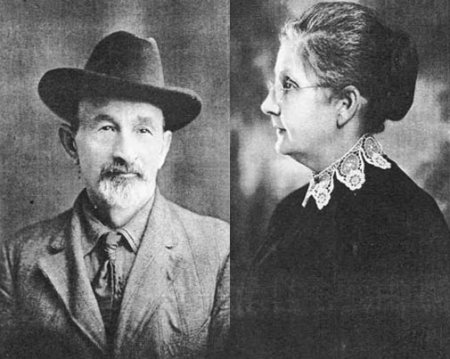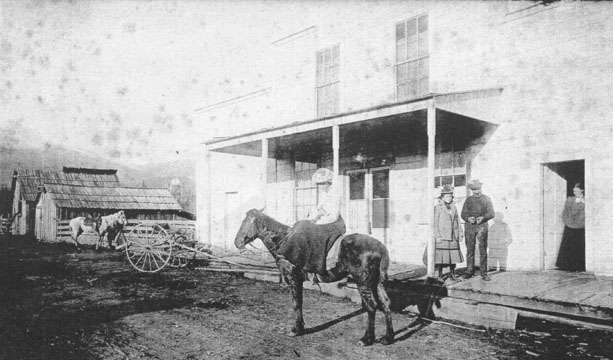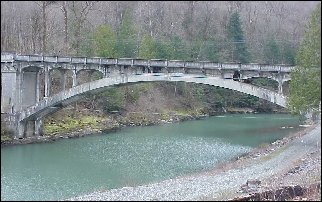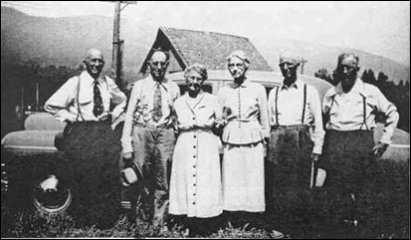Site founded September 1, 2000, passing 350,000 page views in March 2005
These home pages remain free of any charge. We need donations or subscriptions/gifts for students, military and family. Please pass on this website link to your family, relatives, friends and clients.
|

|
of History & Folklore
Subscribers Edition Stories & Photos
The most in-depth, comprehensive site about the Skagit.
Covers from British Columbia to Puget sound. Counties covered: Skagit, Whatcom, Island, San Juan. An evolving history dedicated to the principle of committing random acts of historical kindness
|
Noel V. Bourasaw, editor  810 Central Ave., Sedro-Woolley, Washington, 98284 810 Central Ave., Sedro-Woolley, Washington, 98284
Home of the Tarheel Stomp  Mortimer Cook slept here & named the town Bug Mortimer Cook slept here & named the town Bug
|

|
Henry and Margaret Thompson, English pioneers,
their famous family and
Concrete's Thompson bridge
By Noel V. Bourasaw, Skagit River Journal ©2004
 |
Henry and Margaret Thompso
|
Tommy Thompson, who we chronicle in another story, was one of the first forest rangers in the Cascades and was truly a legend in his own time and place. Like many other early upper Skagit settlers, his family was English. His father, Henry Thompson, was one of the most important early pioneers in the Northwest and achieved quite a bit of fame himself when Tommy was but a youth.
Henry was born in the Mauld's Meaburn, England, in 1852. That small village is inland in the county of Cumbria, the northernmost district of England below Scotland. It is just up the road from Crosby-Ravensworth, the main town in the area. His future wife, Margaret Dodd, was born the same year in Yorkshire, the county southeast of Cumbria. Her birthplace was in the wapentake (or sub-county) of Ewcross, the township of Sedbergh and the hamlet of Soolbank. For those of you interested in English history, the word wapentake came from the old Saxon form of W??pen-tac, which signified "weapon-touch." In the days before the Norman conquest, the villages were organized for military purposes. When a new governor or chief was appointed, all the men assembled and the newly-appointed chief alighted from his horse and held aloft his spear. Every person present approached and touched with his own weapon in token of a mutual bond and agreement to stand by one another. Soolbank is 75 miles west of the large city of York and about 250 miles north of London.
They married in 1874 in Sedbergh and William Henry, their first child, was born in that same hamlet the next April. Their son Richard followed almost exactly a year later but by then they had moved back to Crosby-Ravensworth Henry advanced to become a master carpenter, which entailed hard work during long days and evenings, crafting everything from cabinets to bridges across streams. They soon moved to his hometown of Mauld's Meaburn and the family grew as three girls were born: Elizabeth Ann, who died as an infant, Sarah Elizabeth in 1879 — who they called Lizzie, and Annie, born in 1881. Three years passed before another child arrived and that was Tommy, born on April 17, 1884.
Emigration to the United States

|
Henry Thompson's Birdsview store. The little village of Birdsview was then clustered on the north shore of the Skagit, about where the Cape Horn road meets the Wilde road today and turns north.
|
When Tommy was barely a year old, Henry packed up his wife Margaret and their five surviving children and off they went to Liverpool. Sometime in 1885 they boarded a steam passenger ship and crossed the Atlantic in three weeks to the U.S. When Richard was 91, he recalled that they immediately set off South Dakota, where another child, Anthony, was born in 1886. Ten years old by then, Richard remembered that when they lived in the town of Ledger, his father built a large stock barn out of cement, stone and lumber. By 1889, they moved to Wichita, Kansas, where their last child, Janie, was born on February 18 that year. Richard was learning his father's trade but he went a step further and learned the basics of metallurgy, which would become his craft as an adult. He recalled that while they lived in Wichita, one of Henry's most important projects was building a "big mansion" of stone, oak and metal.
Their move to Washington was sometime between 1889-1891. Whenever they moved, Richard recalled in a 1966 interview with Skagit Valley Herald columnist Royal "Pop" Gunn that his father worked briefly in Tacoma after arriving on Puget sound. We know that they then moved to Snohomish county because that is where he met David Russell. Russell learned the craft of carpentry and woodworking from Henry and later joined the Thompsons in Grassmere [also spelled Grasmere, after an adjoining village and lake in Cumbria], near Concrete, where he would live and build many of the county's earliest bridges. Historian John Conrad wrote in a 1967 eulogy for Richard that when the family first moved to the Skagit river area, they settled first in Birdsview, where Henry operated a store and a post office. Conrad dated that move as 1889 but he also said that Henry had the first store and actually he was predated by F.E. Wyman, who later had a hardware store in Hamilton for several decades. The consensus is that the family set up their store in Birdsview in March 1891.
Concrete's Thompson bridge
 |
Thompson bridge in Concrete. Photo courtesy of Robin Feeney
|
In the book, Buildings of Skagit County, editor Margaret Willis wrote that Henry was actually a cabinet-maker by trade in England. She included a photograph of a house that Henry built for upriver pioneer John Sutter in 1906. By 1914, the old steel bridge that connected the old towns of Baker on the west shore of the Baker river and Cement City on the east was deemed outdated for the needs of the thriving new merged town of Concrete. It had replaced the original wooden bridge that was outdated almost as soon as it was built. One can imagine the shaking that occurred when hundreds of trucks of limestone ore and supplies rumbled across the span, slower and slower each year. Many people assume that Henry Thompson built the bridge, but in fact he was a Skagit county commissioner at the time and he voted with the board on May 1, 1916, to approve the lowest bid of $21, 946.50 by the J.R. Wood Company of Seattle, according to researcher Theresa Trebon. Henry was elected in 1912 as a Republican and was very popular with his Third District upriver constituents, who often called him "Uncle Henry." He was reelected in 1914.
The construction of the single-span cement bridge continued apace in 1916 as Governor Ernest Lister, a Democrat, proclaimed May 16, that year, as Good Roads Day. We will write about the bridge itself in a separate upcoming article, but we note that the efforts to build this longest bridge of its kind in the world at the time were a bipartisan effort. There were no good roads upriver at the time; most of the towns along the Skagit were connected by gravel roads that turned to mud in the fall and winter and to clouds of dust in the summer. Upriver residents who contemplated replacing their horses and buggies with horseless carriages watched the bridge construction closely, wondering if it was a harbinger of times to come. And engineers of various cement companies saw the bridge as a publicity boon.
As 1918 rolled around, Henry Thompson looked forward to dedicating the new bridge that summer. Down in Sedro-Woolley, Frank Evans, the new publisher of the Skagit County Courier, arrived in town in the week of January 26 to take over the newspaper. He was preparing his first editorial on the evening of January 31 when he felt the building rumble and heard a loud crash nearby the office. Deep fog enveloped the town and the engineer of a southbound Northern Pacific freight train plowed through the rear passenger coach of the westbound Great Northern Rockport train that was standing on the crossing at the famous railroad triangle just a block north of downtown. The collision was so violent that parts of the trains were driven into the depot on Eastern avenue and it was soon evident that six people had been killed, including Henry Thompson. He was identified as a "Birdsview farmer and capable, popular county commissioner."
Richard Thompson, then 41 and a blacksmith in Grassmere, was soon appointed to fill his father's un-expired term. Up until that time, he was a respected businessman who was not as well known as his famous father and he had two surviving children. Three others died while very young, including his oldest namesake child, who was also killed in an accident when a horse ran over him. On June 15, 1918, he joined state senator William V. Wells to dedicate the new bridge and name it for his father. A huge crowd of both local people and state and national dignitaries gathered to see this concrete wonder, which for years was famous as the longest single-span cement bridge in the world. Ten years later the lower Baker River Dam became the tallest dam in the world at the time and people flocked to Concrete to view both marvels. We should also note that the county was so pleased with the J.R. Wood Co. work that they were contracted to build the Van Horn bridge over Jackman creek in 1919. Richard was elected as commissioner in his own right in November 1918, also as a Republican, and he was reelected in 1920. Following that term, he returned to business but was urged two years later to run for the post as a Skagit county representative to the state legislature and he served one term. He returned to his Grassmere blacksmith business afterwards and he died in 1967 at age 91. [In May 2004, you will find a link to our feature on Richard's life at our Free Home Page.]
When I was growing up in the Utopia district near Lyman, we often took out-of-town visitors on a tour of the upper valley and we always drove over the Thompson bridge to show them the hairpin curves at both ends that made the journey a hair-raising one for some logging trucks and long-semi-trucks and trailers. The highway then ran through Main street of Concrete, turned sharply north at Brown Wiseman's service station, crossed the bridge and then turned sharply south again and continued southeast through Amasa Everett's old homestead. That was where Amasa found a ridge of limestone in the 1880s and 1890s that was born about 330 million 330 million years ago when the shells of millions of oceanic critters laid a deposit of calcium-carbonate that became limestone and mixed with the clay around the Baker river. [See this website for a fine Seattle Times story: http://seattletimes.nwsource.com/pacificnw/2001/0701/cover.html] In 1972, when the North Cross-State Highway was completed to the Methow valley across the Cascades, a new concrete bridge was built across the Baker river about a mile south. As you will see when you drive through Concrete, the valley is very narrow here, hemmed in by foothills of the Cascades both north and south of the river, so there is not much room for highways. Lone Star Cement Corp., which had bought the original Superior Portland Cement Co. in 1957, stopped operations in Concrete three years before that.
Trebon notes that the Thompson bridge, then a secondary route, was placed on the National Historic Preservation Register in 1982 and it was turned over to the City of Concrete but it was maintained by the Washington State Department of Transportation since Concrete's population was under 5,000 people. In 2004 the bridge is being cleaned up and restored. You can read about the restoration project at the Concrete website
Meanwhile, back in 1904, Tommy, the last child born in England, took a job with the federal Department of the Interior as a fire guard in the Sauk river area, the beginning of a 40-plus-year career. His biography is on a separate page
A very strong gene pool
 |
This photo of the surviving Thompson children was apparently taken sometime in the 1950s. from l. to r.: William Henry, Richard, Sarah Elizabeth, Annie, Tommy, Anthony. All photos of the family on this page are courtesy of Mary Lynne Ball, a descendant of John and Sarah Minkler. As far as we know, they have never been published before.
|
Margaret Thompson died in March 1948 at the home of her son Richard at age 96. She had been a widow for 30 years. This family obviously a very strong, healthy gene pool. Aside from death by accidents, the children and their mother lived to be at least 85 and many lived much longer. Sarah Elizabeth took her middle name from her older sister who died in infancy. According to descendants, she was born on Oct. 26, 1879, in her father's home village of Mauld's Meaburn. She married John Minkler, son of Birdsview pioneer Birdsey D. Minkler, in February 1900. They lived at Minkler's namesake Minkler Lake, two miles west of Lyman. Birdsey and Frank Ries built the Lyman Lumber & Shingle Co. there in 1897, a larger version of the mill that Birdsey and partners built in Lyman ten years earlier. John and Sarah formed the town of Minkler there, which functioned as a market crossroads for the Utopia area that lay south along the Skagit river and John served as postmaster.
The Klondike gold rush had brought capital back to the state after a three-year national depression and the young Minkler couple did very well. Richard was beckoned by the gold rush and in 1899 he spent a year on Lake Bennett in Alaska as the blacksmith for a steamboat company there. When Skagit county was in the depths of the depression back in 1894, he worked as a blacksmith in Shelton. On May 15, 1920, the Minkler Lake mill burned to the ground. Some blamed the fire on IWW "Wobblies" labor organizers. But other old tales point to arson, a common ailment of mills along the river that were past their prime. Garfield Minkler, a partner with his brother, committed suicide on May 20 that year, partially due to financial difficulties. In 1926, John retired and he and Sarah moved west two miles to their farm on the Minkler Highway (also known as the Lyman Highway). John died there in 1959 and Sarah moved to Seattle to live with their son Elmer. She died in Fresno, California. [See our exclusive two-part Minkler story]
William Henry Thompson, the oldest of the children, was also one of the longest lived, dying at age 92 in 1967, the same year as brother Richard's death. He married Myrtle Wanville but we have no information about her. Annie Thompson married the most nationally famous, spouse, Henry O'Malley. In 1924 he was appointed as a commissioner of the federal Bureau of Fisheries, a patronage position under Republican president Calvin Coolidge. He served until 1933 when Democrat Franklin D. Roosevelt took office and was very active in the position, administering fisheries in Washington and halibut fisheries off the Alaska coast. Thompson descendant Mary Lynne Ball recalls that Annie lived as a widow in Seattle for many years after Henry's death in 1936 and was a family favorite. Annie died in Seattle on June 8, 1982, but not before her family and friends threw her a centennial birthday extravaganza on Oct. 31, 1981.
Return to the introductory page for links to more stories in this section.
Story posted on April 15, 2004
Did you enjoy this story? Please consider subscribing to the optional Subscribers Edition. That is how we fund this grand project.
Please report any broken links or files that do not open and we will send you the correct link. Thank you.
|
You can read about our prime sponsors:
Read the history websites of our sponsors and supporters, who help fund research of local history:
Heirloom Gardens Natural Foods at 805B Metcalf street, the original home of Oliver Hammer.
Oliver Hammer Clothes Shop at 817 Metcalf street in downtown Sedro-Woolley, 82 years.
Bus Jungquist Furniture at 829 Metcalf street in downtown Sedro-Woolley, 36 years.
Schooner Tavern/Cocktails at 621 Metcalf street in downtown Sedro-Woolley, across from Hammer Square.
Peace and quiet at the Alpine RV Park, just north of Marblemount on Hwy 20
Park your RV or pitch a tent by the Skagit river, just a short driver from Winthrop or Sedro-Woolley.
Would you like to buy a country church, pews, belfry, bell, pastor's quarters and all? Email us for details.
|
|
|
Did you find what you were looking for? If not, please email us and tell us what you seek and we will put it on our list to research. The more details, the better.
|
Please sign our guestbook so our readers will know where you found out about us, or share something you know about the Skagit River or your memories or those of your family. Share your reactions or suggestions or comment on our Journal. Thank you for taking time out of your busy day to visit our site.
|
Sign Our Guestbook

View Our Guestbook
|
Remember, we welcome correction and criticism. Please click on the email slot at the right to report any problems with these pages or to suggest ideas for future stories. This is a completely free site. We fund it by providing an online magazine for paid subscribers. If you are not already a subscriber and you would like to help support our considerable research costs, you can subscribe for just $20.00 per year. As a paid subscriber, you will receive eight yearly issues plus many rare treats between times, including scans of photos and documents that illustrate local history, before they are shared with anyone else. You can go here for Subscription details and you can read the preview edition to see examples of our in-depth research. You may also order gift subscriptions for friends, family or clients who are interested in local history or students or military people who are away from home. Or you can email us for more details. Do you have scanned photos to share? Or you can mail us copies. See addresses to right.
|
Email us at: journal@stumpranchonline.com

Mail copies/documents to street address: Skagit River Journal, 810 Central Ave., Sedro-Woolley, WA, 98284.
|

 810 Central Ave., Sedro-Woolley, Washington, 98284
810 Central Ave., Sedro-Woolley, Washington, 98284


